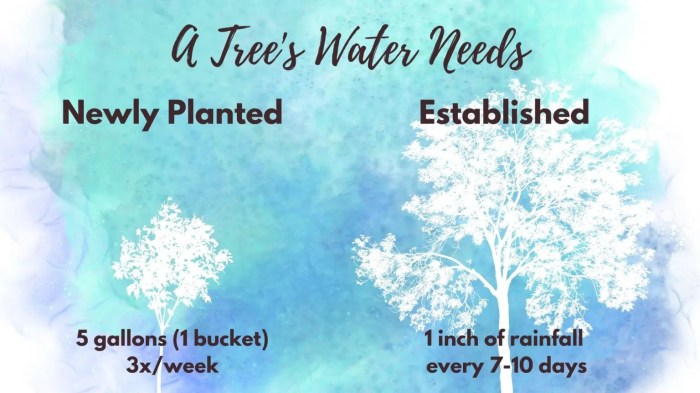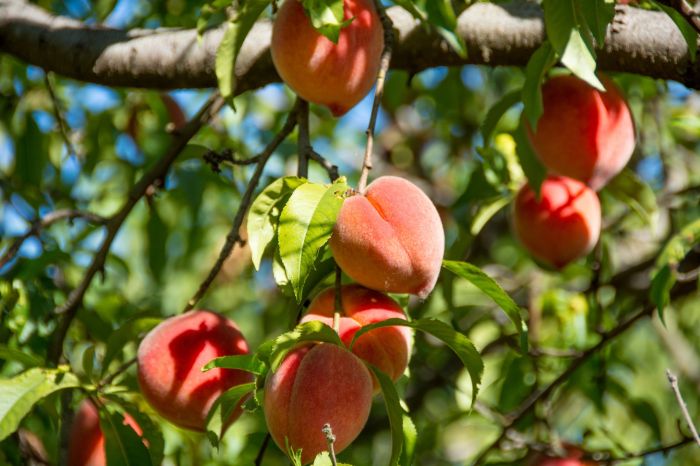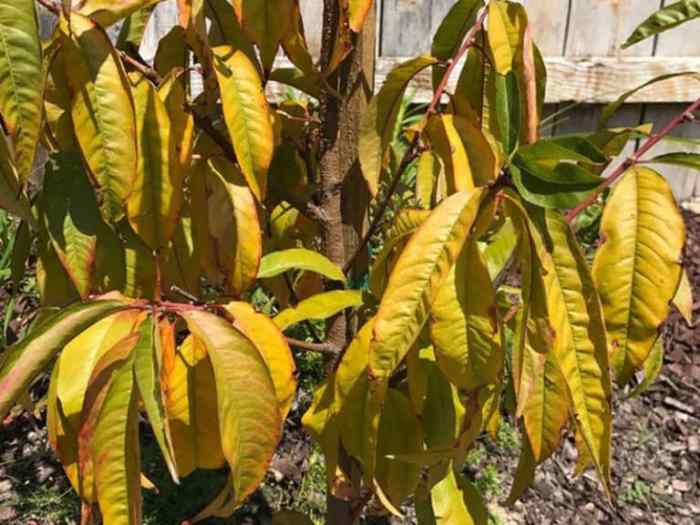How Often to Water Newly Planted Peach Trees
Factors Influencing Watering Frequency: How Often To Water Newly Planted Peach Trees
How often to water newly planted peach trees – The frequency with which you water your newly planted peach tree depends on several interacting factors. Understanding these factors is crucial for ensuring the tree’s health and survival. Consistent monitoring and adjustment of your watering schedule are key to success.
Soil Type and Water Retention
Different soil types have vastly different water retention capabilities. Sandy soils, for example, drain quickly, requiring more frequent watering. Clay soils, on the other hand, retain water for longer periods and may need less frequent watering. Loamy soils, a mixture of sand, silt, and clay, offer a good balance and often require a moderate watering schedule.
Here’s a simple comparison:
- Sandy Soil: Low water retention, requires frequent watering.
- Clay Soil: High water retention, requires less frequent watering, but be cautious of overwatering.
- Loamy Soil: Moderate water retention, requires a balanced watering approach.
Weather Conditions and Watering Needs
Weather significantly impacts a peach tree’s water requirements. Hot, dry, and windy conditions lead to increased evaporation, demanding more frequent watering. Conversely, cooler, humid, and rainy weather reduces the need for supplemental watering.
| Soil Type | Temperature (°C) | Rainfall (mm) | Watering Frequency |
|---|---|---|---|
| Sandy | >30 | <5 | Daily or every other day |
| Loamy | 25-30 | 5-15 | Every 2-3 days |
| Clay | <20 | >15 | Once a week or less |
| Sandy | 20-25 | 10-15 | Every other day |
Tree Size and Root System Development
The size of the tree and the extent of its root system directly influence its water needs. A smaller tree with a less developed root system requires less water than a larger, more established tree. As the root system grows, it can access water from a larger volume of soil, reducing the frequency of watering.
Imagine the root system as a network of pipes. A small, young tree has only a few small pipes, while a mature tree has a vast network of large pipes. The larger network can transport more water, thus requiring less frequent watering.
Watering Methods and Techniques
Several methods can be used to water newly planted peach trees. Each method has its advantages and disadvantages, and the best choice depends on factors like the size of your garden, your available resources, and your personal preferences.
Comparison of Watering Methods

Source: mehrabyannursery.com
- Drip Irrigation:
- Advantages: Efficient water use, minimizes water loss through evaporation, delivers water directly to the roots.
- Disadvantages: Initial cost of setup, potential for clogging.
- Soaker Hoses:
- Advantages: Relatively inexpensive, easy to install, delivers water slowly and evenly.
- Disadvantages: Can be less efficient than drip irrigation, may not be suitable for all soil types.
- Hand Watering:
- Advantages: Simple and inexpensive, allows for close monitoring of soil moisture.
- Disadvantages: Can be time-consuming, may lead to uneven watering, potential for water waste.
Best Practices for Hand Watering
When hand watering, aim for deep, infrequent watering rather than shallow, frequent watering. This encourages deeper root growth. Water until the soil is thoroughly moist to a depth of about 12-18 inches. Check soil moisture regularly using your finger or a soil moisture meter.
Determining if a Peach Tree Needs Watering
To determine if your peach tree needs watering, check the soil moisture at different depths. Dig down a few inches with your finger. If the soil feels dry, it’s time to water. If the soil feels moist, you can wait a bit longer.
- Dig a hole about 6 inches deep near the tree’s drip line.
- Insert your finger into the soil up to the second knuckle.
- If the soil feels dry, water thoroughly.
- If the soil feels moist, monitor the soil moisture and water as needed.
Signs of Underwatering and Overwatering

Source: thespruce.com
Recognizing the symptoms of both underwatering and overwatering is vital for maintaining a healthy peach tree. Both extremes can severely impact the tree’s growth and overall health.
Visual Symptoms of Underwatering and Overwatering, How often to water newly planted peach trees
| Symptom | Underwatering Description | Overwatering Description | Corrective Action |
|---|---|---|---|
| Wilting Leaves | Leaves droop and appear limp. | Leaves may droop slightly but generally appear less vibrant. | Water deeply and thoroughly. |
| Leaf Drop | Premature leaf drop, often starting from the lower branches. | Yellowing leaves, followed by leaf drop. | Adjust watering frequency and improve drainage if necessary. |
| Dry Soil | Soil is dry to the touch, even at deeper levels. | Soil is constantly soggy and waterlogged. | Water deeply and regularly for underwatering, improve drainage for overwatering. |
| Stunted Growth | Slow or minimal growth. | Slow or stunted growth, possibly accompanied by yellowing leaves. | Adjust watering, ensure proper drainage. |
Long-Term Effects of Improper Watering
Chronic underwatering leads to stunted growth, reduced fruit production, and increased susceptibility to pests and diseases. Overwatering, on the other hand, can cause root rot, leading to tree decline and potentially death.
Establishing a Consistent Watering Schedule
A consistent watering schedule is essential, but it needs to be adapted to the season and weather conditions. Regular monitoring and adjustments based on observed conditions are crucial.
Newly planted peach trees need frequent watering, especially during their establishment phase. The frequency depends on factors like soil type and weather, but aiming for consistent moisture is key. This contrasts sharply with the infrequent watering needs of other plants; for example, consider learning more about how often you should water a snake plant by checking out this helpful guide: how often do you water a snake plant.
Returning to peach trees, remember that overwatering can be just as detrimental as underwatering, so monitor soil moisture carefully.
Sample Watering Schedule

Source: yardandgardenguru.com
| Season | Average Temperature Range (°C) | Recommended Watering Frequency | Additional Notes |
|---|---|---|---|
| Spring | 10-20 | Every 3-5 days | Increase frequency during dry spells. |
| Summer | 25-35 | Daily or every other day | Monitor soil moisture closely; may need to water more frequently during heatwaves. |
| Autumn | 15-25 | Every 3-5 days | Reduce frequency as temperatures cool down. |
| Winter | 0-10 | Infrequent or none, depending on rainfall | Water only if the soil is extremely dry. |
Maintaining Consistent Soil Moisture
Use a soil moisture meter to regularly check soil moisture levels. Consider using mulch to help retain soil moisture and reduce the frequency of watering. Water deeply and less often to encourage deeper root growth.
Mulching and its Impact on Watering
Applying mulch around your newly planted peach tree offers several benefits, primarily improving soil moisture retention and reducing the need for frequent watering. It also helps regulate soil temperature and suppress weeds.
Benefits of Mulching
Mulch acts as a barrier, reducing evaporation from the soil surface. This conserves soil moisture, reducing the frequency of watering. It also improves soil structure and fertility.
Mulch Types and Application
- Organic Mulches: Wood chips, shredded bark, straw. These decompose over time, adding nutrients to the soil.
- Inorganic Mulches: Gravel, rocks. These don’t decompose and offer long-lasting weed suppression.
Apply a 2-4 inch layer of mulch around the tree, keeping it a few inches away from the trunk to prevent rot.
Advantages and Disadvantages of Mulch Types
- Wood chips:
- Advantages: Readily available, good water retention, improves soil structure.
- Disadvantages: Can harbor pests if not properly composted.
- Shredded bark:
- Advantages: Excellent water retention, aesthetically pleasing.
- Disadvantages: Can be more expensive than wood chips.
- Straw:
- Advantages: Inexpensive, readily available, good for weed suppression.
- Disadvantages: Can blow away easily, may need reapplication.
Popular Questions
What type of water is best for peach trees?
Use clean, chlorine-free water whenever possible. Chlorine can harm young roots.
How deep should I water my peach tree?
Water deeply enough to moisten the soil to a depth of 12-18 inches, encouraging deep root growth.
Should I water my peach tree in the morning or evening?
Morning watering is generally preferred, allowing leaves to dry before nightfall and reducing the risk of fungal diseases.
My peach tree leaves are curling. Is it underwatered or overwatered?
Curling leaves can indicate both underwatering (leaves will be dry and brittle) or overwatering (leaves may be yellow and limp). Check the soil moisture to determine the cause.




















